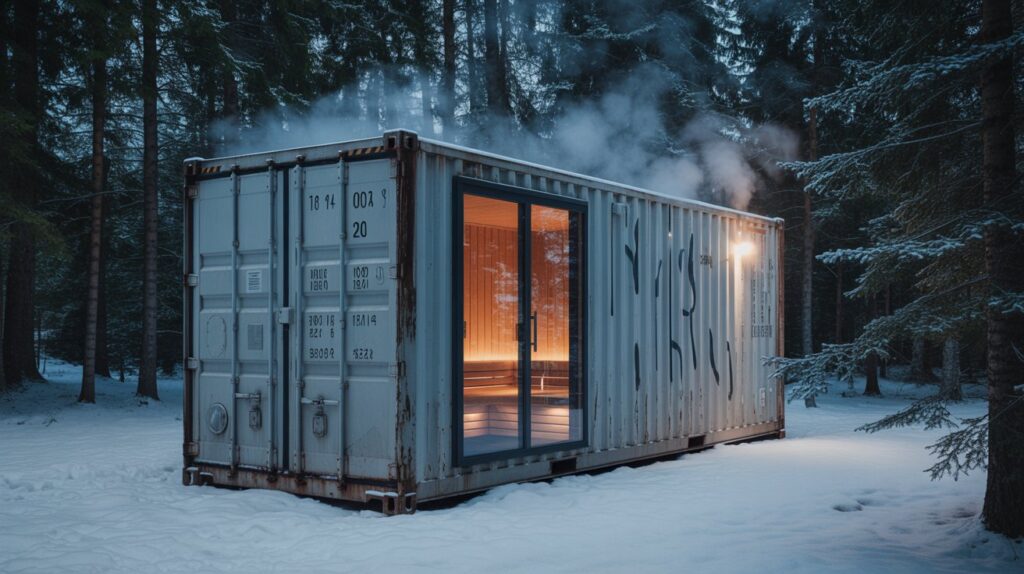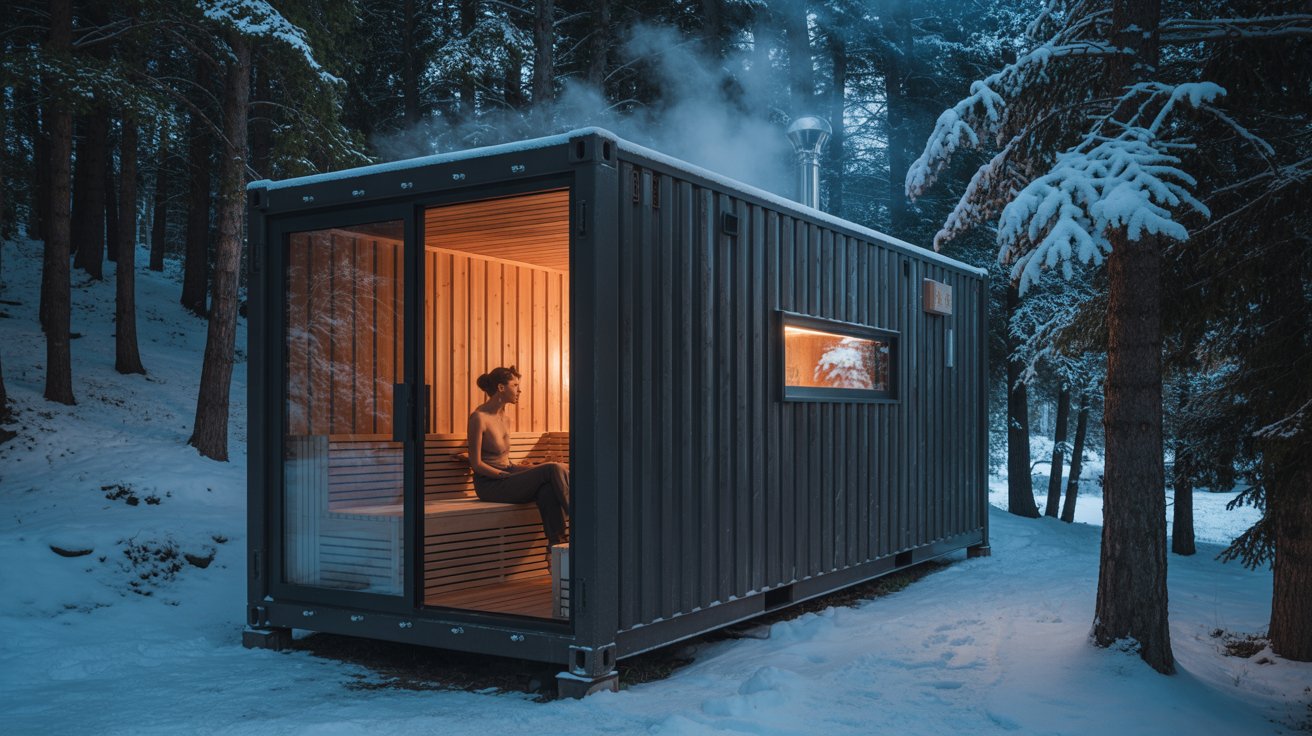Can you envision transforming an ordinary shipping container into a luxurious sauna? It’s an exciting project that might sound ambitious, yet it is entirely achievable! By converting a simple shipping container into a sauna, you can create a personal retreat that fits your backyard perfectly. Whether you’re a seasoned DIY enthusiast or a beginner, the journey of building a sauna can be rewarding. Let’s dive into the details and see how you can bring this unique idea to life.

Why Choose a Shipping Container for Your Sauna?
Choosing a shipping container as the base of your sauna provides several benefits. First, they are made from durable materials, ensuring longevity. They are also portable, allowing for flexibility in placement. Moreover, using a shipping container contributes to sustainable building practices by recycling a structure that might otherwise go unused.
Planning Your Sauna Project
A successful sauna project begins with thorough planning. You need to consider various factors such as size, layout, and design style that will influence your final creation.
Determining the Size
The size of your sauna will largely depend on the dimensions of the shipping container you choose. Standard containers come in various sizes, with the most common being 20 feet and 40 feet in length. Your choice will depend on the available space in your backyard and your personal preference.
| Container Size | Dimensions (L x W x H) |
|---|---|
| 20-foot | 20’ x 8’ x 8.5’ |
| 40-foot | 40’ x 8’ x 8.5’ |
Designing the Layout
The interior layout of your sauna should focus on comfort and utility. Typically, this involves benches for seating, a stove or heater for steam production, and perhaps some shelving for essentials. Spend time sketching possible layouts to envision how the space will be used efficiently.
Setting a Budget
Budgeting is a crucial step, dictating the scope and quality of your project. Keep in mind the costs of purchasing a container, necessary materials for insulation, wood paneling, a heating system, and any labor costs if you plan on hiring help. A well-forecasted budget will save you from unforeseen expenses, allowing the process to run more smoothly.
Prepping the Site
Having a proper setup site ensures your sauna is stable and accessible. Key aspects involve preparing a solid foundation and adhering to any local building codes.
Choosing the Right Location
Pick a location in your yard that’s easily accessible but maintains privacy. Consider the view, whether you want a serene garden setting or something more secluded.
Preparing the Foundation
Shipping containers require a solid foundation to rest on. Options include concrete slabs, piers, or gravel beds. This step is critical to prevent moisture issues and ensure stability.
Understanding Legal and Zoning Requirements
It’s essential to familiarize yourself with local zoning laws and obtain any necessary permits. Compliance with local building codes ensures that your project is legally sound and safe.
Insulating the Container
Proper insulation is crucial to provide energy efficiency and comfort. Without it, the sauna will struggle to maintain the desired temperature.
Types of Insulation
Several types of insulation can be used in a shipping container sauna:
- Spray Foam: Offers excellent thermal resistance and acts as an air barrier.
- Rigid Foam Board: Provides good insulation and is moisture resistant.
- Fiberglass Batts: Economical and easy to install, but less effective against moisture.
Installing the Insulation
The insulation process involves cutting your selected material to fit snugly between the steel framing of the container. Ensure there’s a vapor barrier on the warm side of the insulation to prevent condensation issues.

Creating the Interior
Focusing on the interior layout and design can transform the container into a comfortable, inviting sauna. This is where you bring together form and function.
Wood Paneling and Benches
Saunas typically feature wood interiors, offering both aesthetics and functionality. Cedar and spruce are popular choices due to their ability to handle heat and moisture. You’ll also need to construct sturdy benches for seating, concentrating on comfort and space optimization.
Installing Windows and Ventilation
Adding windows in your sauna can introduce natural light and enhance the feeling of closeness to nature. However, it’s vital to ensure they are well-sealed to maintain the heat. Ventilation system installations are equally vital, ensuring fresh air circulation and maintaining sauna safety.
Integrating the Heating System
The heating system is the core of your sauna experience, responsible for producing the dry or wet heat needed.
Types of Heaters
You can choose from several sauna heater types, each offering unique benefits:
- Electric Heater: Easy to use and maintain, with simple installation compared to other options.
- Wood Burning Stove: Offers a traditional experience and aroma, but requires a chimney installation.
- Infrared Heaters: Provides direct heat to the skin without warming the air, offering a different sauna experience.
Safety Considerations for Heaters
Heater safety is paramount. Ensure you follow manufacturer instructions closely during installation. Maintain safe distances between the heater and any combustible materials, and install heat shields if necessary.
Final Touches and Aesthetic Enhancements
Attention to detail makes the final experience much more enjoyable and satisfying.
Lighting
Opt for subdued lighting to create a calming atmosphere. LED strips or recessed lights serve as good options that are safe in high humidity.
Accessories and Features
Consider features like a sound system for ambient music, essential oil diffusers for aroma, and water buckets with ladles for steam creation.
Maintenance and Upkeep
Even after the build is complete, your sauna will require regular upkeep to function well and remain enjoyable.
Regular Cleaning
Regular cleaning is essential to prevent mold and maintain hygiene. Wipe surfaces with a microfiber cloth, sanitize seating areas, and ensure flooring remains clean.
Inspecting Heating and Ventilation
Consistent checks on heating and ventilation systems are critical. This goes a long way toward preempting any issues and prolonging the sauna’s operational life.
Conclusion
Building a sauna from a shipping container is an exciting endeavor that combines creativity, practicality, and sustainability. By following the steps outlined, you can transform a humble container into a luxurious personal retreat. Remember, attention to each aspect—from design to installation—improves not only the sauna’s functionality but your personal satisfaction as well. Whether it’s a quiet moment of relaxation or a lively family gathering, your sauna will be a place of comfort and joy.

